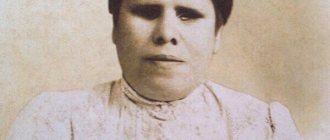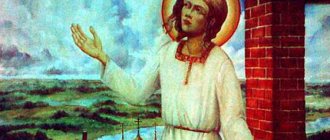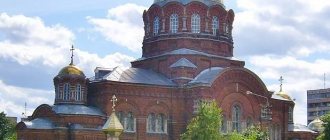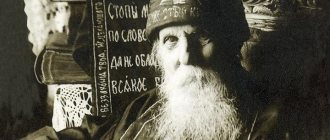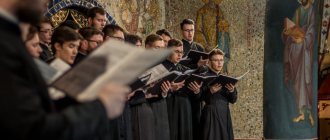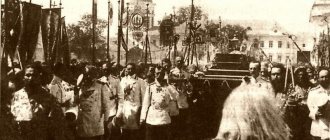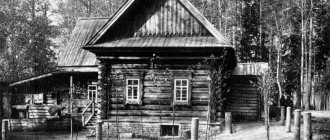St. Seraphim of Sarov is one of the most revered saints in Rus'. The life of Seraphim of Sarov tells how miracles began to happen to him already in childhood, and having become a monk, the Monk Seraphim began to manifest them himself - primarily with the incredible feats that he performed: for example, he prayed for three years on a stone and almost did not eat . Or he fed wild animals that flocked to him from all over the forest and became meek next to them.
But the Seraphim monk is also one of those saints who left not only the tradition of their own ascetic life, but also the teaching (not to mention the whole teaching): about grace. He taught: Christianity is not a set of ethical rules where it is important only to be a good person, but a higher goal - to gain the grace of the Holy Spirit, to change the very nature of man. And then - the person will be sanctified, and the world around him will be transformed in the most miraculous way!
Venerable Seraphim of Sarov feeds a bear
Teachings of St. Seraphim of Sarov
To some extent, teaching is truly the most important thing that St. Seraphim of Sarov left behind.
“Find the spirit of peace and thousands around you will be saved” - this is one of the most famous sayings of St. Seraphim of Sarov, who simply and laconically conveys the essence of his teaching.
Finding peace of mind and finding grace is the main goal of a Christian, and not fulfilling the commandments. Fulfilling the commandments is natural for a person, and this must be done in any case, but a person on earth has a higher goal than doing good deeds and not offending loved ones. This goal is deification: that is, a change in the character of the soul already here on earth.
Indeed, the Monk Seraphim of Sarov tried to convey the ideas of hesychasm - the “Greek” teaching, one of whose apologists was St. Gregory Palamas in the 14th century, and which is being built on Holy Mount Athos to this day. The idea of hesychasm is based on the action of the mind, and not just action.
Saint Gregory Palamas
The Monk Seraphim of Sarov reminded that the life of a Christian begins not with actions or even with thoughts, but even earlier - with the character of his soul. Therefore, an Orthodox Christian must not only look at his thoughts (after all, all actions come from them), but also further direct his hopes and aspirations - to the state of his soul. A soul that calls on the Holy Spirit and finds its true wholeness and true healing only through the acquisition of Grace and therefore in Christ.
Well, keeping the commandments and living a godly life is just one of the best tools to achieve this higher goal: gaining a “peaceful spirit.”
Demon excuses
The enemy of the human race, as we know, always makes efforts to shake the faith of the righteous and prevent him from serving God. So the unclean spirit took up arms against Saint Seraphim, trying to intimidate him and force him to stop his hermitage. Many times eerie voices, the growling of animals and other fruits of the devil's delusion sounded in his ears. He tried to shake the saint’s body and even hit him on the ground. But everything was overcome by fasting and prayer. And the enemy was forced to retreat.
To top it all off, the human enemy sent robbers against St. Seraphim. They brutally beat him, almost took his life, demanding money. But the saint endured everything with humility, and later even forgave his offenders. For a long time after the beatings he suffered, he could not walk and remained bent over until the end of his days. The third appearance of the Most Holy Theotokos to Father Seraphim dates back to this period. As the previous time, She was accompanied by the apostles Peter and John, and She also said, pointing to Seraphim: “This is from Our generation.”
Seraphim of Sarov: years of life - when he lived
The Monk Seraphim of Sarov lived in the 18th and 19th centuries. He was born in 1754 and died in 1833.
He lived for 78 years, and during this time the country in which he lived - the Russian Empire - survived six emperors and changed a lot: turning from a great state into a real empire, which eventually managed to defeat Napoleon himself.
Kings “captured” by St. Seraphim of Sarov: Empress Elizabeth; Peter II; Catherine II; Peter III; Alexander I; Nicholas I. Although, of course, the Monk Seraphim himself thought less about the kings of the earth and thought more about the Eternal Kingdom, which is what his life tells about.
Interesting Facts
- It is known that Father Seraphim planted a vegetable garden and set up an apiary next to his cell. Perhaps the cleric’s presence of honey gave rise to the legend of hand-feeding bears.
- According to rumors, the first coffin of the saint, made of marble and silver, was a gift from Nicholas II. In addition, there is information that the Empress herself embroidered the shrine cover.
- The source for painting the icon of Seraphim of Sarov was a portrait created 5 years before the death of the hieromonk by an artist named Serebryakov, who later became a monk.
Seraphim of Sarov: short biography
Biographies of saints in the Church are usually called lives. The life of the Monk Serafino is quite extensive, because the elder led a very simple lifestyle and from a young age strove for monasticism.
Therefore, the short life of St. Seraphim can be summarized in a few sentences:
- born 1833;
- at the age of 22 he left home and became a monk,
- ten years later he was tonsured a monk,
- he spent his entire monastic life in the forest near the Sarov Monastery or on retreat in the monastery itself
- and died at the age of 78.
However, the life of any ascetic does not consist in external facts, but in the routine of life and the structure of internal life, which is difficult to describe on the pages of books or on a website. And the life of Seraphim of Sarov was hardly filled with internal exploits, which showed that with true unity with the Lord, human strength is truly inexhaustible, and grace can sanctify a person so that wild animals will come to him to worship, and not thieves - neither heavenly nor the more earthly, will not be afraid!
The desire for monasticism
When Prokhor turned sixteen years old, the desire to devote his life to God finally matured in him. When he talked to his mother about possible monasticism, he met with sympathy. Agafya blessed her son by placing a copper cross around his neck, which he did not remove for the rest of his life. Having prayed to God and sat down on the path, Prokhor left his home forever.
First, he went to Kyiv, where the holy elder Dosifei, having blessed him, ordered him to go to the Sarov Hermitage to Father Abbot Pachomius, there to strive as a novice. The life of Seraphim of Sarov speaks with great warmth about Father Pachomius as a zealous servant of God and an unusually kind person.
Miracles of St. Seraphim of Sarov
Miraculous phenomena began to happen to the monk Serafino when he was still a seven-year-old child, Prokhor. He fell from the spire to the ground, but survived.
The feats that he accomplished during his thirty-year stay in the forest can be considered a real miracle, but more on that later.
His holy life made the meek the most formidable animals. The monk said that at night wolves, hares, foxes, snakes and mice and even a big bear came to him. And he fed everyone, and miraculously there was enough food for everyone. “No matter how much bread I ate,” said the ascetic, “it was a miracle that it did not fall into the basket!”
Like any saint, the Monk Seraphim of Sarov did not strive to work miracles and in every miraculous phenomenon he saw first of all the generosity and love of God and an example of how limitless the world becomes during his life with Christ.
The devil's attacks intensified. At first they manifested themselves in a mystical way - during prayer, the elder Seraphim could be thrown back and thrown to the ground - these demons “had fun”. And one day - during his exploits in the forest - he was attacked by the most loyal thieves. He was the devil, seeing the spiritual fortitude of the elder, now attacked using earthly tools “at hand” - people - to break the monk’s spirit in this “mundane” way.
The robbers beat the monk, broke his ribs, fractured his skull and inflicted many more wounds. Some time later they found the wounded Seraphim of Sarov, the doctors were surprised: it was not clear how he survived. The monk himself said that the other day the Mother of God appeared to the monk, and this eventually calmed him down, helped him abandon everything to the will of God and thereby save his life.
The appearance of the Mother of God to St. Seraphim of Sarov is also one of the miracles that happened to him more than once. According to legend, there were twelve of them. The first - in childhood, when Prokhor was 9 years old - the boy became seriously ill and the Mother of God promised to heal him. It was after this that he decided to become a monk. And the last appearance occurred a couple of years before his death - when the Most Holy Theotokos appeared to him, surrounded by John the Baptist, John the Theologian and 12 virgins.
Childhood and youth of the saint
At the end of the eighteenth century (the exact date is unknown), a boy was born into the family of the wealthy merchant Moshnin in the city of Kursk, who was named Prokhor. He was God-fearing from childhood, loved to spend time in prayer, and not in games with peers, like many. His father left this world early, and Prokhor was left alone with his mother.
Already from childhood, the Lord revealed His Providence about him . When the boy was five years old, he and his mother were at the construction of the cathedral. When she was distracted, Prokhor climbed to the very top of the bell tower and fell from there. The mother ran in despair to look for what was left of her son. But what was her surprise and joy when she saw her son safe and healthy, as if he had never fallen from such a height.
The Lord showed another miracle during the boy's illness . Prokhor was seriously ill, so his mother did not hope that he would survive. But a religious procession with the miraculous icon of the Mother of God “The Sign” was just passing by their house. After the boy kissed her, he began to quickly recover.
Thus, it became clear to everyone that this was not an ordinary child. And he himself dreamed of leaving this sinful world and serving God as a monk. But he felt sorry for his mother that she would be left all alone.
The exploits of St. Seraphim of Sarov
The future Elder Seraphim accomplished his first visible feat even before he was tonsured as a monk - when from Kursk, where he was born and lived, he went to the Kiev Pechersk Lavra: to venerate the relics of the cave saints and receive a blessing for monasticism. He did not travel by train, did not drive a car, and did not fly on an airplane. In those days, pilgrimage was not a comfortable “tourism”, as it is now, but a real thing.
Kiev-Pechersk Lavra, 19th century
But, of course, first of all, he became famous for the asceticism he brought, already being a monk. From the very beginning it differed from the fraternity by its strict statute. And he spent 30 years of his life either as a hermit in the forest a few kilometers from the Sarov Monastery, or in the house itself, but in isolation.
His way of life in the forest seems incredible. San Serafino could wear the same clothes all year round, he wore chains, and sometimes ate the same grass.
His most famous feat is the feat of mastery over the columns, when he alternately remained in prayer on two stones for a thousand days and a thousand nights.
He began to receive visitors only in the last years of his life - and it was then that people learned about Seraphim of Sarov and glorified him as a saint during his lifetime.
Eldership
People learned about the elder and began to come to him for advice from everywhere. He had foresight and predicted many events, including those related to Russia and the monastery. The elder also predicted his own glorification, that his relics would be carried in a religious procession to the Diveyevo Monastery. The saint founded this women's monastery shortly before his death.
The nuns and novices from Diveevo loved the elder and often came to him. One day the saint ordered to dig a ditch around the monastery, saying that he saw the Mother of God Herself walking through it. This ditch was dug, the saint ordered to walk along it every day with the prayer “Rejoice, Virgin Mary . The monk predicted that in the last times the Antichrist would approach the monastery, but would not be able to enter it, because the ditch would light up with fire up to the sky.
He advised many laymen who to marry, and ordered some to go into monasticism. The elder also healed the sick. Not only people, but even animals loved the saint and went to him. One nun saw a bear come to him, which he tamed with bread.
The elder herself was burdened by human attention, by the crowds of people who came, which prevented him from praying. One day he prayed to the Mother of God, and a tree fell on the way to his cell. For fifteen years he did not receive people and was in seclusion. And then crowds of people came to him again.
The elder greeted everyone who came with great love, saying to everyone: “My joy, Christ is risen!” The emperor himself came to see him.
The relics of Seraphim of Sarov: where are they located?
The relics of St. Seraphim of Sarov are now kept in the Seraphim-Diveevsky Monastery. There you can worship them. Diveevsky Monastery is located in the Nizhny Novgorod region. From Moscow, for example, you can get to Nizhny Novgorod by train, and then by bus to Diveevo. The bus schedule can be found here
By car: 450 km from the Moscow Ring Road.
There are hotels and private houses in the monastery, and you can always find somewhere to stay, but it is best to book accommodation in advance, especially during major religious holidays or on saint's days.
And in Moscow there is the courtyard of the Diveyevo Monastery - it’s a two-minute walk from the Prospekt Mira-Koltsevaya metro station - if you follow the path to the Garden Ring. The courtyard with the house church inside is located right on Mira Avenue:
Home temple - what is it and how does it differ from an ordinary temple?
Canonization and discovery of relics
They began to venerate Seraphim during his lifetime, and the elder was canonized at the insistence of Nicholas II’s wife, Alexandra Fedorovna. This happened on July 19, 1902. According to rumors, the imperial couple believed that it was thanks to the prayers of Father Seraphim that an heir appeared in the royal family. In addition, the saint was loved by the people, and the Romanovs, in matters of faith, sought not to distance themselves from their subjects.
This development of events caused a whole scandal, headed by Konstantin Pobedonostsev, who served as the emperor’s representative in the Holy Synod. The latter did not consider the tsar’s order to correspond to church canons.
Beaten by robbers.
Posted by Rusu Silvia on Friday, January 15, 2021
Seraphim of Sarov with the robbers
Partly, they were in no hurry to canonize Seraphim of Sarov because of information indicating the saint’s sympathy for the Old Believers. There is still debate about how the hieromonk actually treated schismatics.
In the fall of 1920, the district congress of Soviets in Temnikov decided to open the shrine containing the elder’s relics, which happened at the end of the year. In 1922, the remains of Seraphim of Sarov ended up in the Museum of Religious Art in the Donskoy Monastery, where they were then simply lost.
In 1990, unknown human bones were discovered in the collections of the Museum of the History of Religion at the Kazan Cathedral in St. Petersburg. Thanks to the preserved autopsy report, it was possible to establish that the remains belong to Seraphim of Sarov. The discovery of the relics took place on August 1, 1991, after the solemn meeting of the hieromonk’s tomb in Diveyevo.
Icon of Seraphim of Sarov
This is how one of the most common images of St. Seraphim appears. (The picture shows an icon that is kept in the Holy Trinity Sergius Lavra):
St. Seraphim of Sarov is one of the most revered saints in Rus', so his icon can be found and venerated in almost any church.
Reverend Father Seraphim, pray to God for us!
Heritage
Orthodox Christians continue to pray to Seraphim of Sarov. The press has repeatedly reported about healings from various ailments of people who came to the relics of the saint, predictions and other miracles associated with the elder.
Believers know more than one prayer to Father Seraphim. The monk helps in healing, admirers ask the miracle worker to give harmony and mental fortitude. Often people come to the icon so that the saint can guide them on the right path. Often businessmen pray to Seraphim, wanting success in business and trade. Young girls ask to send a companion.
Today there are churches of Seraphim of Sarov in almost every city in Russia, including Moscow, St. Petersburg and Kazan. There are parishes in honor of the saint in small villages. Akathists to the saint are heard even overseas.
“Obtain a peaceful spirit and thousands around you will be saved.”
St. Seraphim of Sarov
The Monk Seraphim of Sarov was born on July 19, 1754 in the city of Kursk into the pious merchant family of Isidore and Agafy Moshnin. In Holy Baptism he was named Prokhor, in honor of Saint Prokhor, an apostle from the age of 70 (January 4 and August 10). Isidor Moshnin took contracts for the construction of stone buildings; at the end of his life he began building a church in the name of St. Sergius of Radonezh in the city of Kursk, but died before the completion of the work. For three years, Saint Prokhor lost his father, who bequeathed to his wife to complete the construction of the temple. From infancy, Saint Prokhor was under the special protection of God's Providence. One day Agafia Moshnina took her son with her to build a temple and he stumbled and fell from the bell tower; but the Lord preserved the life of the future lamp of the Church: the frightened mother, going downstairs, found her son unharmed. From his childhood, Saint Prokhor loved to attend church services and read the Holy Scriptures and the Chetii-Minea, but most of all he loved to pray in solitude.
In his tenth year, Saint Prokhor fell seriously ill; The Mother of God appeared to him in a dream, promising to heal him from his illness. Soon a religious procession with the icon of the Sign of the Most Holy Theotokos passed through the courtyard of the Moshnin estate; the mother brought Saint Prokhor out to venerate the holy icon, after which he quickly recovered.
Even in his adolescence, Saint Prokhor decided to devote his life to serving God and enter a monastery. His mother blessed him for his monastic path with a copper crucifix, which the monk wore on his chest all his life. Not long before, Saint Prokhor and pilgrims set off on foot from Kursk to Kyiv to worship the saints of the Pechersk saints. The schemamonk elder Dosifei, who was visited by Saint Prokhor, blessed him to go to the Sarov hermitage and save himself there. Returning briefly to his parents' house, Saint Prokhor said goodbye to his mother and relatives forever. On November 20, 1778, he came to Sarov, where the wise elder Father Pachomius was the rector. Having designated the young man as a novice, he appointed Elder Joseph as his confessor. Under the leadership of the elder, Saint Prokhor underwent many monastic obediences: he was a cell attendant, worked in the bakery, prosphora and carpentry shop, carried out the duties of a sexton, and performed everything with zeal and zeal. By constant work he protected himself from boredom - this, as he later said, “the most dangerous temptation for new monks, which is cured by prayer, abstinence from idle talk, feasible handicraft, reading the Word of God and patience, because it is born from cowardice, carelessness and idle talk.” . Following the example of other monks who retired into the forest to pray, Saint Prokhor asked the elder’s blessing to also go into the forest in his free time, where he prayed the Jesus Prayer in complete solitude.
Two years later, the novice Saint Prokhor fell ill with dropsy, his body became swollen, and he experienced severe suffering. The mentor, Father Joseph, and other elders who loved Saint Prokhor looked after him. The illness lasted about three years, and not once did anyone hear a word of grumbling from him. The elders wanted to call a doctor to him, to which Saint Prochorus said to Father Pachomius: “I have given myself, Holy Father, to the True Physician of souls and bodies - our Lord Jesus Christ and His Most Pure Mother...” - and asked to be given communion of the Holy Mysteries. Then Saint Prokhor had a vision: the Mother of God appeared in an indescribable light, accompanied by the holy apostles Peter and John the Theologian. Pointing her hand at the sick man, the Most Holy Virgin said to John: “This one is from our generation.” Then She touched the patient’s side with the staff, and immediately the liquid that filled the body began to flow out through the hole that had formed, and he quickly recovered. Soon, on the site of the appearance of the Mother of God, a hospital church was built, one of the chapels of which was consecrated in the name of the Monks Zosima and Savvaty, Solovetsky wonderworkers. Saint Prokhor built the altar for the chapel from cypress wood and always received the Holy Mysteries in this church.
After spending eight years as a novice in the Sarov monastery, he took monastic vows with the name Seraphim (Hebrew - fiery), which so successfully expresses his truly fiery love for God and desire to serve Him zealously. A year later, the Monk Seraphim of Sarov was ordained to the rank of hierodeacon. Burning in spirit, he served in the temple every day. The Lord vouchsafed the monk visions of grace: he repeatedly saw holy Angels serving with the brethren. The monk was granted a special vision of grace during the Divine Liturgy on Maundy Thursday, which was performed by the rector, Father Pachomius, and Elder Joseph. When, after singing the troparions, the monk said: “Lord, save the pious,” and, standing at the royal doors, pointed the orarion at those praying with the exclamation “and forever and ever,” suddenly a bright ray overshadowed him. Raising his eyes, the Monk Seraphim of Sarov saw the Lord Jesus Christ walking through the air from the western doors of the temple, surrounded by the Heavenly Ethereal Forces. Having reached the pulpit, the Lord blessed all those praying and entered the local image to the right of the royal doors. The Monk Seraphim of Sarov, in spiritual delight, could not utter a word or leave his place. He was led arm in arm into the altar, where he stood for another three hours, his face changing from the great grace that illuminated him.
After the vision, the monk intensified his exploits: during the day he worked in the monastery, and spent his nights in prayer in a deserted forest cell.
In 1793, at the age of 39, the Monk Seraphim of Sarov was ordained to the rank of hieromonk. After the death of the abbot, Father Pachomius, the monk, having his dying blessing for a new feat - living in the desert, also took the blessing from the new abbot, Father Isaiah, and went to a desert cell several kilometers from the monastery, in a dense forest. Here he began to indulge in solitary prayers, coming to the monastery only on Saturday, before the all-night vigil, and returning to his cell after the Liturgy, during which he received communion of the Holy Mysteries. The Monk Seraphim of Sarov performed his cell prayer rule according to the rules of the ancient desert dwellers; I never parted with the Holy Gospel, reading the entire New Testament during the week, and also read patristic and liturgical books. Near the cell he planted a vegetable garden and built a beekeeper. Earning food for himself, the monk kept a very strict fast, eating once a day, and on Wednesday and Friday he abstained from food. In the first week of Holy Pentecost, he did not take food until Saturday, when he received Holy Communion.
The holy elder, in solitude, was sometimes so immersed in inner heartfelt prayer that he remained motionless for a long time, neither hearing nor seeing anything around him. The hermits who visited him from time to time - schemamonk Mark the Silent and hierodeacon Alexander, having caught the saint in such prayer, withdrew with reverence. For about three years the monk ate only one herb, snitis, which grew around his cell. In addition to the brethren, lay people began to come to him more and more often for advice and blessings. This violated his privacy. Having asked for the blessing of the abbot, the monk stopped access to himself to the laity, and then to everyone else, having received a sign that the Lord approved of his idea of complete silence. Through the saint’s prayer, the road to his deserted cell was blocked by huge branches of centuries-old pine trees. Now only birds, which flocked in large numbers to the saint, and wild animals visited him.
Seeing the saint’s exploits, the devil brought mental warfare upon the saint—a persistent, prolonged temptation. To repel the onslaught of the enemy, the Monk Seraphim of Sarov intensified his labors by taking upon himself the feat of stylite mongering. Every night he climbed a huge stone in the forest and prayed with his hands raised, crying out; “God, be merciful to me, a sinner.” During the day, he prayed in his cell on another stone, which he brought from the forest. The saint prayed like this for 1000 days and nights.
The devil, disgraced by the monk, planned to kill him and sent robbers. The monk, who was working in the garden, had an ax in his hands, but he did not defend himself, remembering the words of the Lord: “Those who take the sword will perish by the sword” (Matthew 26:52). The robbers beat the saint mercilessly, broke his head, and broke several ribs. Having destroyed everything in the cell and finding nothing in it except an icon and a few potatoes, they were ashamed of their crime and left.
The monk, having regained consciousness, crawled to his cell and, suffering painfully, lay there all night. The next morning, with great difficulty, he reached the monastery. The brethren were horrified when they saw the wounded ascetic. The monk lay there for eight days, suffering from his wounds. The Queen of Heaven appeared to him in a subtle dream with the apostles Peter and John. Touching the head of the monk, the Most Holy Virgin granted him healing. After this, the Monk Seraphim of Sarov spent about five months in the monastery, and then again went to the desert cell. Remaining bent over, the monk walked, leaning on a staff or hatchet, but forgave his offenders and asked them not to punish them. After the death of the rector, Father Isaiah, who had been his friend since the saint’s youth, he took upon himself the feat of silence. If the saint met a person in the forest, he fell on his face and did not get up until the passerby moved away. The elder spent about three years in such silence, ceasing to visit the monastery on Sundays. The fruit of his great asceticism was the acquisition of peace of soul and joy in the Holy Spirit. The Monk Seraphim of Sarov subsequently said to one of the monks of the monastery: “...my joy, I pray to you, acquire a peaceful spirit, and then thousands of souls will be saved around you.”
The new abbot, Father Nifont, suggested that Father Seraphim of Sarov either continue to come to the monastery on Sundays to participate in Divine services, or return to the monastery. The monk chose the latter, since it became difficult for him to walk from the desert to the monastery. In the spring of 1810, he returned to the monastery after a fifteen-year stay in the desert. Without breaking his silence, he added seclusion to this feat and, without going anywhere or receiving anyone, he was constantly in prayer and contemplation of God. While in retreat, the Monk Seraphim of Sarov was granted special grace-filled gifts from God - clairvoyance and miracle-working. On November 25, 1825, the Mother of God, together with the two saints celebrated on this day - Clement of Rome and Peter of Alexandria - appeared in a dream vision to the elder and commanded him to come out of seclusion.
The Monk Seraphim of Sarov opened the doors of his cell to everyone. The elder saw the hearts of people and, as a spiritual doctor, healed mental and physical illnesses with prayer to God and a word of grace. Those who came to St. Seraphim of Sarov for edification felt his great love and listened with tenderness to the kind words with which he addressed people; “My joy, my treasure.” The elder began to visit his desert cell and the spring called Bogoslovsky, near which a small cell was built for him. When leaving his cell, the elder always carried a knapsack over his shoulders, which contained the Gospel and a load of stones and sand. When asked why he was doing this, the saint humbly answered: “I torment him who torments me.”
In the last period of his life, the Monk Seraphim of Sarov took special care of his beloved brainchild - the Diveyevo women's monastery. While still in the rank of hierodeacon, he accompanied the late rector Father Pachomius to the Diveyevo community to see the abbess nun Alexandra, a great ascetic, and then Father Pachomius blessed the reverend to take care of the “Diveyevo orphans.”
Disciples and spiritual children helped the saint to care for the Diveyevo community: Mikhail Vasilyevich Manturov, who was healed by the monk from a serious illness and, on the advice of the elder, took upon himself the feat of voluntary poverty; Elena Vasilievna Manturova, one of the Diveyevo sisters; Nikolai Alexandrovich Motovilov, also healed by the monk. ON THE. Motovilov recorded the wonderful teaching of St. Seraphim of Sarov about the purpose of Christian life.
In the last years of the life of the Monk Seraphim, one healed by him saw him standing in the air during prayer. The saint strictly forbade talking about this before his death. Everyone knew and revered St. Seraphim of Sarov as a great ascetic and wonderworker. Since 1831, the monk foreshadowed the upcoming famine to many, and, on his advice, the Sarov monastery made a supply of bread for six years, as a result of which they were saved from famine. A year and nine months before his death, on the Feast of the Annunciation, the Venerable Seraphim of Sarov was once again honored with the appearance of the Queen of Heaven, accompanied by John the Baptist of the Lord, the Apostle John the Theologian and twelve virgins, holy martyrs and saints. The Most Holy Virgin talked for a long time with the monk, entrusting the Diveyevo sisters to him. Having finished the conversation, She told him: “Soon, My beloved, you will be with us”...
The Monk Seraphim began to noticeably weaken and spoke to many about his imminent death. At that time, he was often seen at the coffin, which stood in the entryway of his cell and which he had prepared for himself. The monk himself indicated the place where he should be buried - near the altar of the Assumption Cathedral. On January 1, 1833, the Venerable Seraphim of Sarov came for the last time to the hospital Zosimo-Savvatievskaya Church for the Liturgy and took communion of the Holy Mysteries, after which he blessed the brethren and said goodbye, saying: “Save yourself, do not lose heart, stay awake, today crowns are being prepared for us.” On January 2, the monk’s cell attendant, Father Pavel, left his cell at six o’clock in the morning, heading to the church, and smelled a burning smell coming from the monk’s cell; Candles were always burning in the saint’s cell, and he said: “As long as I am alive, there will be no fire, but when I die, my death will be revealed by fire.” When the doors were opened, it turned out that books and other things were smoldering, and the monk himself was kneeling before the icon of the Mother of God in a position of prayer, but already lifeless.
Wanting to give admirers the opportunity to say goodbye to the old man, who was already lying in the coffin, they left the deceased unburied for eight whole days; he lay in the Assumption Cathedral, and at that time thousands of residents from surrounding areas and neighboring provinces flocked to his tomb. In 1891, a chapel was built over the tomb of St. Seraphim of Sarov.
In 1903, the solemn glorification of the great saint of God, St. Seraphim of Sarov, took place. On July 19, the saint’s birthday, his relics were opened with great triumph and placed in a prepared shrine. The long-awaited event was accompanied by many miracles and healings. Very widely revered during his lifetime, St. Seraphim of Sarov becomes one of the most beloved saints of the Russian people.
Troparion of St. Seraphim
voice 4
From your youth you loved Christ, O blessed one,/ and you ardently longed for that One to work,/ you labored in the desert with unceasing prayer and labor,/ having acquired the love of Christ with a tender heart,/ you appeared as the chosen one beloved of God to the Mother./ For this reason we cry out to you:/ / save us with your prayers, Seraphim, our reverend father.
Kontakion of St. Seraphim
voice 2
Leaving the beauty of the world and the corruption in it, O Reverend, / you moved into the Sarov monastery / and, having lived there like an angel, / you were the path to salvation for many, / for this reason, you glorified Christ, Father Seraphim, / and enriched you with the gift of healings and miracles ./ We also cry out to you: Hail, Seraphim, our reverend father.
Source: www.eparhia-saratov.ru
“I had no goal of exposing the life of a saint”
— So you saw that in reality, some key stories in the life of the saint either happened differently or did not happen at all. But for what reason did such a vision develop among believers? Is this a simple human craving for the miraculous? Or are there some more complex laws of the Christian and specifically Orthodox worldview behind this?
“I repeat that the most significant moments in the saint’s biography—falling from a bell tower, feeding a bear, praying on a stone—cannot be ignored. They are real, memorable, reflected in lithographs and icons, which were located in the red corners of not only peasant huts. I just corrected some of them based on archival documents.
I also want to note that among the first biographers of the reverend there were no real writers. There were poorly educated eyewitnesses who, sometimes trying to embellish the elder’s biography, lost their sense of proportion. For example, the desire to show St. Seraphim as a man overcoming all the hardships of life, relying only on his own strength, led to the fact that for a long time the name of his novice, Paul, was kept silent.
In this sense, it is significant that, for example, around the Optina elders we do not encounter such a layering of various legends. And this is due precisely to the fact that Optina Pustyn, in comparison with the Sarov Monastery, is a more ancient monastery - the biographies of the elders were created here, one might say, by professionals in their field. The Sarov hermitage was mainly peasant, and the “Tales” about the saint, figuratively speaking, were written by ordinary people. Therefore, the text sometimes seems primitive - I, of course, mean the first biographies.
However, it is worth noting that such speculation about the life of a famous person is a constantly occurring phenomenon. This is the fate of everyone whose biography attracts thousands of people. After all, it is somehow perceived, interpreted, translated, and in the process of such reflection some glitches always arise, which sometimes distort the real historical texture.
This is the task of the researcher - to remove such layers and get, if possible, to reality. It is not for nothing that I chose the words of the abbot of the Sarov Hermitage, Isaiah (Putilov), as the epigraph for my book: “Indeed, just as the decrease in truth in the descriptions of righteous men and anything worthy of note, so their excessive praise takes away their honor.” Unfortunately, the first biographers, and indeed the biographers of modern times, did not always follow this path.
Raev V.E. Portrait of Elder Seraphim. 1830
— So we are talking specifically about human weakness, about the desire to discern the supernatural in everything? Why then does the Church not correct what is clearly embellished in the biography of Seraphim of Sarov?
— Firstly, too little time has passed to make such changes. I published the documents only now, and the Church is never in a hurry, especially in those matters that concern the life of such significant saints as St. Seraphim. And this, in my opinion, is wise.
It is important that the events set forth precisely in the official life of the saint, accepted by the Church, are beyond doubt. Immediately after canonization, church censorship sifted out from the saint’s biography everything that was clearly colored by human imagination.
Secondly, I am not at all a supporter of making any significant changes to the lives of saints on the basis of even the most conscientious historical research. The hagiographic genre is not a historical chronicle or a collection of testimonies. This is a story about the Christian feat of a really existing person, who is formed and written according to completely different canons - with an emphasis on the manifestations of his personal holiness, on the moments through which the process of human transformation increasingly emerges. In the end, we are not comparing an icon and a painting - they are from completely different worlds and, obviously, serve different purposes. Also here. You must always remember this boundary and not erase it.
— What goal did you set for yourself in your research?
— Help to see the person being described from a historical point of view. However, this perspective in no way obscures the holistic reality that life reveals to us. In the process of writing the book, I did not set out to expose this life or any myths. However, the myths themselves have a right to exist, since behind them you can always find a veiled truth, which is described not in scientific language, but in another, which means this “text” needs to be deciphered differently.
The facts I found in archives and books are presented to correct those inconsistencies that were made by researchers and writers of previous generations due to an understandable ignorance of this topic. After all, they did not yet have in their hands the documents that I had.
It is also important to understand that there is no conflict between the historical study of this or that material and established life. There are just different ways of working, different goals, ways of interpretation. In France, for example, there are descriptions of the lives of saints for a variety of people. This includes canonical hagiography, adaptations for Catholics, studies for secular people, and even comics for children.
— Your research does not impose any conclusions. But today people often tend not to be calm about the facts, but to immediately begin to interpret. And it is quite likely that there will be those who will say: this, supposedly, was what needed to be proven - Orthodoxy is based on fairy tales, which are believed by people without critical thinking. What would you answer to this? Have you ever had this question yourself?
- It didn’t occur to me. And it cannot be said that Orthodoxy rests on fairy tales. Otherwise, the history of the Church would not have been counted for two thousand years. Different interpretations of historical facts and events were present before, they are present today - and it is probably impossible to do without it. This is completely normal.
For me, another thought is more important in all this: there are situations in life when a person is ready to believe in any miracle, strives to feel it for himself, and sometimes it happens, contrary to the claims of skeptics. Such situations fall outside the scope of external scientific studies, because they relate to phenomena of a completely different order. These are, as it were, internal, personal “key moments” that are understandable only to the person who experienced them and are a priori not suitable for any, even the most refined, rational manipulations. And here everyone already proves to himself exactly what he wants.
